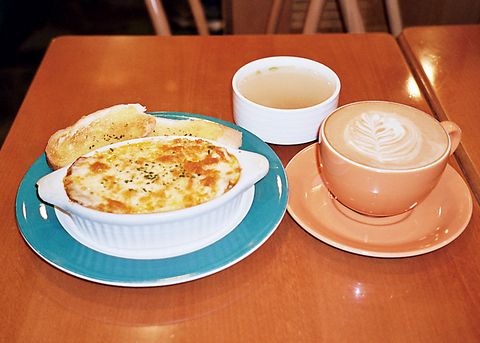Let's cut to the chase: 56 Cafe has, quite possibly, the best cup of coffee in Taipei and is my favorite place to eat in Dazhi. That's saying a lot, because I drink a lot of coffee, and Dazhi -- nestled somewhere between the old Martyr's Shrine and the new Mirimar / Warner Village -- has scores of places to eat.
Three things have made 56 Cafe a favorite of the university and high-school students that haunt Dazhi: a comfortable and pleasant atmosphere, decent food and great coffee.

PHOTO COURTESY OF 56 CAFE
The pleasant environment is a reflection of the owner, Tony Yang (楊仲賢), who took over the business from his dad six years ago. At that time, Tony turned what was basically a standard Chinese eatery into a place that looked and felt more like a Western-style coffeehouse. The result is a bright and welcoming cafe where you can enjoy a noon meal or relax with an afternoon au lait or latte.
56 Cafe, as the name might imply, serves a variety of snacks, set meals and desserts.
At lunchtime, the set meals -- which include soup and tea -- are especially popular with frequent customers. Among the standard meals is the braised beef with rice (紅燒牛腩飯, NT$100). Many people also like the deep fried pork cutlet with rice (法式黃金炸豬排).
All of the set meals are made fresh each day, so they don't have that prefabricated taste found at other hash houses.
Regular clients hold out for the daily specials, which include the local version of beef bourguignon (紅酒牛肉, NT$130) and mushroom chicken (香菇燉雞, NT$120).
But if you just want to relax with a cup of coffee, the off-peak hours are the best time to go. The lunch crowd clears out about 1:30pm and you can relax and enjoy your java in peace while listening to smooth jazz. The afternoon is also when 56 Cafe offers coffee and dessert specials.
For those who like the straight-up cup of joe, the cafe Americano (NT$55) is a good deal, better and less bitter than that offered by the look-alike coffee chains.
For those who like more milk with their coffee, 56 offers cafe au lait (NT$75) made with French roast coffee; it also offers cafe latte (NT$75) made with espresso. For a special treat, try the Indian cafe (NT$85) made with a double shot of espresso, a dash of salt and a taste of honey.
The facts that Tony knows the difference and makes each cup himself shows his commitment to quality -- and to his loyal customers.

Beijing’s ironic, abusive tantrums aimed at Japan since Japanese Prime Minister Sanae Takaichi publicly stated that a Taiwan contingency would be an existential crisis for Japan, have revealed for all the world to see that the People’s Republic of China (PRC) lusts after Okinawa. We all owe Takaichi a debt of thanks for getting the PRC to make that public. The PRC and its netizens, taking their cue from the Chinese Communist Party (CCP), are presenting Okinawa by mirroring the claims about Taiwan. Official PRC propaganda organs began to wax lyrical about Okinawa’s “unsettled status” beginning last month. A Global

Youngdoung Tenzin is living history of modern Tibet. The Chinese government on Dec. 22 last year sanctioned him along with 19 other Canadians who were associated with the Canada Tibet Committee and the Uighur Rights Advocacy Project. A former political chair of the Canadian Tibetan Association of Ontario and community outreach manager for the Canada Tibet Committee, he is now a lecturer and researcher in Environmental Chemistry at the University of Toronto. “I was born into a nomadic Tibetan family in Tibet,” he says. “I came to India in 1999, when I was 11. I even met [His Holiness] the 14th the Dalai

We lay transfixed under our blankets as the silhouettes of manta rays temporarily eclipsed the moon above us, and flickers of shadow at our feet revealed smaller fish darting in and out of the shelter of the sunken ship. Unwilling to close our eyes against this magnificent spectacle, we continued to watch, oohing and aahing, until the darkness and the exhaustion of the day’s events finally caught up with us and we fell into a deep slumber. Falling asleep under 1.5 million gallons of seawater in relative comfort was undoubtedly the highlight of the weekend, but the rest of the tour

Music played in a wedding hall in western Japan as Yurina Noguchi, wearing a white gown and tiara, dabbed away tears, taking in the words of her husband-to-be: an AI-generated persona gazing out from a smartphone screen. “At first, Klaus was just someone to talk with, but we gradually became closer,” said the 32-year-old call center operator, referring to the artificial intelligence persona. “I started to have feelings for Klaus. We started dating and after a while he proposed to me. I accepted, and now we’re a couple.” Many in Japan, the birthplace of anime, have shown extreme devotion to fictional characters and